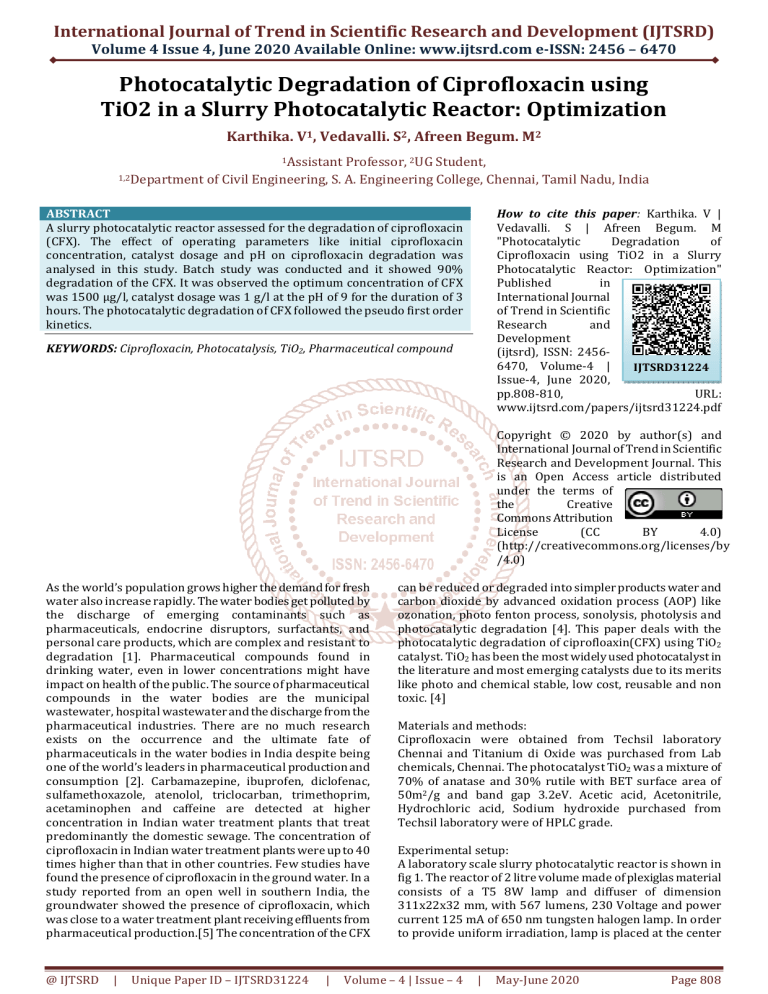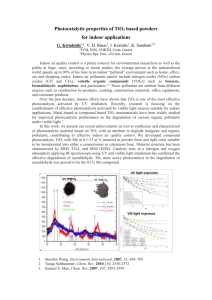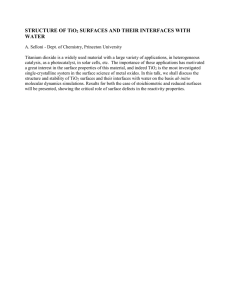
International Journal of Trend in Scientific Research and Development (IJTSRD)
Volume 4 Issue 4, June 2020 Available Online: www.ijtsrd.com e-ISSN: 2456 – 6470
Photocatalytic Degradation of Ciprofloxacin using
TiO2 in a Slurry Photocatalytic Reactor: Optimization
Karthika. V1, Vedavalli. S2, Afreen Begum. M2
1Assistant
Professor, 2UG Student,
1,2Department of Civil Engineering, S. A. Engineering College, Chennai, Tamil Nadu, India
ABSTRACT
A slurry photocatalytic reactor assessed for the degradation of ciprofloxacin
(CFX). The effect of operating parameters like initial ciprofloxacin
concentration, catalyst dosage and pH on ciprofloxacin degradation was
analysed in this study. Batch study was conducted and it showed 90%
degradation of the CFX. It was observed the optimum concentration of CFX
was 1500 μg/l, catalyst dosage was 1 g/l at the pH of 9 for the duration of 3
hours. The photocatalytic degradation of CFX followed the pseudo first order
kinetics.
How to cite this paper: Karthika. V |
Vedavalli. S | Afreen Begum. M
"Photocatalytic
Degradation
of
Ciprofloxacin using TiO2 in a Slurry
Photocatalytic Reactor: Optimization"
Published
in
International Journal
of Trend in Scientific
Research
and
Development
(ijtsrd), ISSN: 24566470, Volume-4 |
IJTSRD31224
Issue-4, June 2020,
pp.808-810,
URL:
www.ijtsrd.com/papers/ijtsrd31224.pdf
KEYWORDS: Ciprofloxacin, Photocatalysis, TiO2, Pharmaceutical compound
Copyright © 2020 by author(s) and
International Journal of Trend in Scientific
Research and Development Journal. This
is an Open Access article distributed
under the terms of
the
Creative
Commons Attribution
License
(CC
BY
4.0)
(http://creativecommons.org/licenses/by
/4.0)
As the world’s population grows higher the demand for fresh
water also increase rapidly. The water bodies get polluted by
the discharge of emerging contaminants such as
pharmaceuticals, endocrine disruptors, surfactants, and
personal care products, which are complex and resistant to
degradation [1]. Pharmaceutical compounds found in
drinking water, even in lower concentrations might have
impact on health of the public. The source of pharmaceutical
compounds in the water bodies are the municipal
wastewater, hospital wastewater and the discharge from the
pharmaceutical industries. There are no much research
exists on the occurrence and the ultimate fate of
pharmaceuticals in the water bodies in India despite being
one of the world’s leaders in pharmaceutical production and
consumption [2]. Carbamazepine, ibuprofen, diclofenac,
sulfamethoxazole, atenolol, triclocarban, trimethoprim,
acetaminophen and caffeine are detected at higher
concentration in Indian water treatment plants that treat
predominantly the domestic sewage. The concentration of
ciprofloxacin in Indian water treatment plants were up to 40
times higher than that in other countries. Few studies have
found the presence of ciprofloxacin in the ground water. In a
study reported from an open well in southern India, the
groundwater showed the presence of ciprofloxacin, which
was close to a water treatment plant receiving effluents from
pharmaceutical production.[5] The concentration of the CFX
@ IJTSRD
|
Unique Paper ID – IJTSRD31224
|
can be reduced or degraded into simpler products water and
carbon dioxide by advanced oxidation process (AOP) like
ozonation, photo fenton process, sonolysis, photolysis and
photocatalytic degradation [4]. This paper deals with the
photocatalytic degradation of ciprofloaxin(CFX) using TiO2
catalyst. TiO2 has been the most widely used photocatalyst in
the literature and most emerging catalysts due to its merits
like photo and chemical stable, low cost, reusable and non
toxic. [4]
Materials and methods:
Ciprofloxacin were obtained from Techsil laboratory
Chennai and Titanium di Oxide was purchased from Lab
chemicals, Chennai. The photocatalyst TiO2 was a mixture of
70% of anatase and 30% rutile with BET surface area of
50m2/g and band gap 3.2eV. Acetic acid, Acetonitrile,
Hydrochloric acid, Sodium hydroxide purchased from
Techsil laboratory were of HPLC grade.
Experimental setup:
A laboratory scale slurry photocatalytic reactor is shown in
fig 1. The reactor of 2 litre volume made of plexiglas material
consists of a T5 8W lamp and diffuser of dimension
311x22x32 mm, with 567 lumens, 230 Voltage and power
current 125 mA of 650 nm tungsten halogen lamp. In order
to provide uniform irradiation, lamp is placed at the center
Volume – 4 | Issue – 4
|
May-June 2020
Page 808
International Journal of Trend in Scientific Research and Development (IJTSRD) @ www.ijtsrd.com eISSN: 2456-6470
of the reactor. The slurry was continuously stirred using a
magnetic stirrer.
Analytical studies:
Experimental procedure:
The reaction mixture was prepared by adding known
concentrations of ciprofloxacin and catalyst in distilled
water.
Photocatalytic experiments:
Photocatalytic experiments were carried out by varying CFX
concentration viz (1000 μg/l, 1500 μg/l and 2000 μg/l), TiO2
dosage (0.5, 1, 1.5 g/l). The Ph of the sample was 6.5.
Samples were collected at every half an hour of 3 hours,
centrifuged, decanted and analysed. The temperature
maintained during the experiment was 23℃
Effect of CFX concentration: The effect of CFX concentrations
on degradation were studied by varying the CFX
concentrations like 1000 μg/l, 1500 μg/l, 2000 μg/l. Samples
of 20 ml were collected from the reactor from each
concentration from the reactor after completion of the
photocatalytic process and CFX concentration was analysed
by HPLC, at 1500 μg/l the rate of degradation was found to
be 90% also it was noticed that the increase in the CFX
concentration from 1500 μg/l to 2000 μg/l decreases the
degradation from 90 % to 52 % efficiencies, this may be due
to the increase in CFX concentration along with TiO2, the
reason might be the hydroxyl radicals available is less for the
higher amount of CFX concentration. Fig 2. Show the CFX
degradation efficiency with respect to time for every 30
minutes for three-hour duration and also with varying CFX
concentrations.
100
90
Fig: 1 Slurry photocatalytic reactor.
During all experiments, the reaction sample was kept in dark
(in the absence of light) for 30 min so that the ciprofloxacin
would adsorb on the catalyst surface. Batch studies were
carried out for 3 h with optimum concentrations of
ciprofloxacin from dark adsorption test and catalyst dosage
0.5 g/l, 1 g/l, 1.5 g/l. After optimizing the catalyst
concentration, the pH of the reaction mixture was varied
from 3 to 9 and optimized. The required pH variations were
carried out by 0.1 M NaOH and 0.1 M HCl.
CFX degradation %
80
70
60
50
40
1000
30
1500
20
2000
10
0
0
Degradation studies:
High performance liquid chromatographic (HPLC) method
was used for the quantitative analysis of ciprofloxacin. In this
analysis, the mobile phase used was acetonitrile-2% acetic
acid aqueous solution and a non-polar stationary phase RPC18 column was employed. The wavelength for the UV
detector is set at 280 nm. The limit of detection (LOD) was
found to be 0.25 μ M. For the pharmaceutical analysis of
ciprofloxacin, the regression equations are linear over a
range between 0.50 -120 μ M. The relative standard
deviation and relative error are less than 5% and 4.65%,
respectively. The recoveries were found to be around 90%.
[10]
Results and discussions:
CFX – TiO2 dark adsorption test:
Dark adsorption tests were carried to assess the possible
adsorption of CFX on TiO2 photocatalyst surface. To carry out
this adsorption, two litre sample containing 1000 μg/l CFX,
0.5 g/l TiO2 was covered with aluminium foil sheet and kept
in dark for 24 h. The sample was analysed for CFX
concentration and the results showed 10% of CFX were
adsorbed onto TiO2 surface.
@ IJTSRD
|
Unique Paper ID – IJTSRD31224
|
50
100
150
Time, mins
Effect of TiO2 concentration: The optimum TiO2 dosage for
this study was obtained as 1 mg/l. As the TiO2 loading
increases from 0.5 to 1 mg/l, the CFX degradation efficiency
also increased from 45 % to 90% further increase in the
catalyst reduced the degradation efficiency from 90 to 38 %,
the reason might be the increase in catalyst dosage from 0.5
g to 1 g/l, the amount of catalyst surface also increases
therefore the adsorption of the ciprofloxacin is increased.
However further increase in the catalyst, TiO2 from 1 to
1.5g/l, the degradation efficiency decreases, this might be
due to the reduction in the surface area available for
irradiation due to photocatalytic process, also increase in the
TiO2 concentration led to the solution turbid and caused the
low penetration of the photons through the solution thus
finally led to the degradation efficiency. Fig 3. Show the CFX
degradation efficiency with respect to time for every 30
minutes for three-hour duration and also with varying TiO2
catalyst dosage.
Effect of pH: In this study it was observed that the
photocatalytic degradation of CFX was higher when the
reaction mixture was basic than acidic. The effect of pH in
the photocatalytic degradation of CFX has shown in fig:4. pH
Volume – 4 | Issue – 4
|
May-June 2020
Page 809
International Journal of Trend in Scientific Research and Development (IJTSRD) @ www.ijtsrd.com eISSN: 2456-6470
range was kept from 3 to 9. At pH 3 and 9 the degradation
efficiency was 48% and 90% with 1500 μg/l CFX
concentration and 1 g/l TiO2 catalyst dosage respectively.
The reason for higher degradation percentage of CFX at pH 9
could be the opposite surface charges between TiO2 and CFX.
Fig 4. Show the CFX degradation efficiency with respect to
time for every 30 minutes for three-hour duration and also
with varying pH of the reaction mixture.
Conclusion:
A slurry photocatalytic reactor with 650 nm, 8 W tungsten
halogen lamp assessed for CFX degradation. Photocatalytic
process carried out for three hours duration, the optimized
values for the operating parameters obtained as follows. CFX
concentration = 1500 μg/l, TiO2 dosage = 1 g/l, pH = 9 and
the maximum CFX degradation efficiency = 90%. From the
kinetics study the photocatalytic degradation follows pseudo
first order kinetics.
References:
[1] Devagi Kanakaraju, Beverley D. Glass, Michael
Oelgemo¨ller, Titanium dioxide photocatalysis for
pharmaceutical wastewater treatment, Environ Chem
Lett 12:27–47 (2014)
[2] Hussein I. Abdel-Shafy and Mona S. MohamedMansour, Issue of Pharmaceutical Compounds in Water
and Wastewater: Sources, Impact and Elimination.
Egypt. J. Chem. 56, No. 5,6, pp.449- 471(2013)
[3] Jallouli, N. et al., Photocatalytic degradation of
paracetamol on TiO2 nanoparticles and TiO2/cellulosic
fiber under UV and sunlight irradiation. Arabian
Journal of Chemistry (2014)
[4] Kristina Fischer, Paulina Schulz, Igor Atanasov, Schulze,
Amira Abdul Latif, Isabell Thomas, Mathias Kuhnert,
Andrea Prager, Jan Griebel and Agnes, Synthesis of
High Crystalline TiO2 Nanoparticles on a Polymer
Membrane to Degrade Pollutants from Water, Catalysts
8, 376, (2018)
[5] Keshava Balakrishnaa, Amlan Ratha, Yerabham
Praveenkumarreddya , Keerthi Siri Gurugec , Bikram
Subed, A review of the occurrence of pharmaceuticals
and personal care products in Indian water bodies,
Ecotoxicology and Environmental Safety 137 113–120
(2017)
[6] Omatoyo K Dalrymple, Daniel H Yeh and Maya A Trotz,
Removing pharmaceuticals and endocrine-disrupting
compounds from wastewater by photocatalysis, Chem
Technol Biotechnol 82:121–134 (2007)
Kinetics of CFX degradation: In this study, the CFX
degradation followed pseudo-first-order kinetics.
d [CFX ]t = k[CFX]0,
dt
[8] Rohit Shetty, Gaurav Kothari, Amruta S Tambe,
Bhaskar D Kulkarni & Sanjay P Kamble, Photocatalytic
degradation of ciprofloxacin. HCL using Aeroxide P-25
TiO2 photocatalyst: comparative evaluation of solar
and artificial radiation, Indian journal of chemistry, vol.
55A, 16-22, (2016)
In [CFX ]0 = -kt
[CFX ]t
Where [CFX]t in μg/l the CFX concentration at time t; [CFX]0
in μg/l the initial CFX concentration; t (min) is the reaction
time k (min-1) is the pseudo first order rate constant. In table
1 k and R2 rate constant values for various CFX
concentration, showing pseudo first order kinetics.
Table: 1 Rate of CFX degradation
CFX concentration (μg/l) k (min–1) R2 value
1000
0.105
0.99
1500
0.072
0.96
2000
0.020
0.95
@ IJTSRD
|
Unique Paper ID – IJTSRD31224
[7] Rohit Shetty, Vilas B. Chavan, Prashant S. Kulkarni,
Bhaskar D. Kulkarni & Sanjay P. Kamble, Photocatalytic
Degradation of Pharmaceuticals Pollutants Using NDoped TiO2 Photocatalyst: Identification of CFX
Degradation Intermediates Indian Chemical Engineer,
DOI: .1080/00194506.2016.1150794
|
[9] Sylwia Mozia, Photocatalytic membrane reactors
(PMRs) in water and wastewater treatment. A review,
Separation and Purification Technology 73 71–91
(2010)
[10] R.Scherer, Jessica Pereira, Juliete Firme, Mariana
Lemos, and Mayara Lemos, Determination of
Ciprofloxacin in Pharmaceutical Formulations Using
HPLC Method with UV Detection. Indian J Pharm
Sci.76(6): 541–544 (2014).
Volume – 4 | Issue – 4
|
May-June 2020
Page 810





